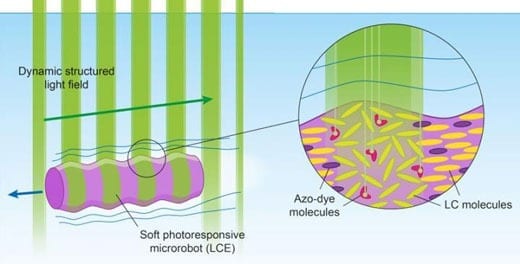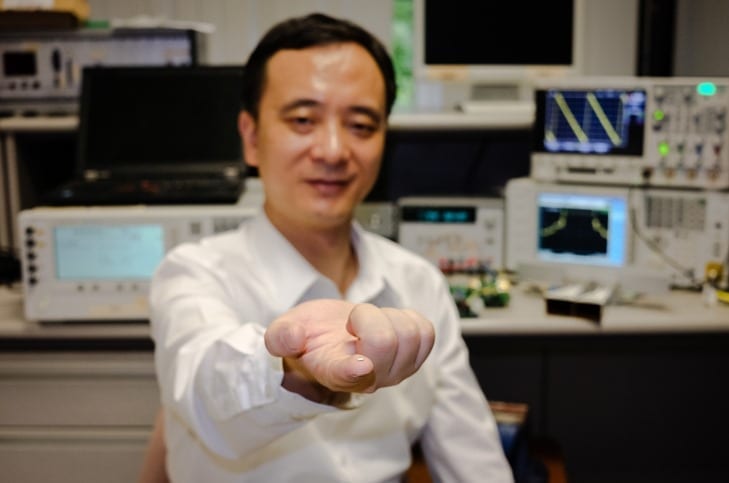
Stefano Palagi
Ciliates can do amazing things: Being so tiny, the water in which they live is like thick honey to these microorganisms. In spite of this, however, they are able to self-propel through water by the synchronized movement of thousands of extremely thin filaments on their outer skin, called cilia. Researchers from the Max Planck Institute for Intelligent Systems in Stuttgart are now moving robots that are barely perceptible to the human eye in a similar manner through liquids.
For these microswimmers, the scientists are neither employing complex driving elements nor external forces such as magnetic fields. The team of scientists headed by Peer Fischer have built a ciliate-inspired model using a material that combines the properties of liquid crystals and elastic rubbers, rendering the body capable of self-propelling upon exposure to green light.
Mini submarines navigating the human body and detecting and curing diseases may still be the stuff of science fiction, but applications for the new development in Stuttgart could see the light-powered materials take the form of tiny medical assistants at the end of an endoscope.
Their tiny size makes life extremely difficult for swimming microorganisms. As their movement has virtually no momentum, the friction between the water and their outer skin slows them down considerably – much like trying to swim through thick honey. The viscosity of the medium also prevents the formation of turbulences, something that could transfer the force to the water and thereby drive the swimmer. For this reason, the filaments beat in a coordinated wave-like movement that runs along the entire body of the single-celled organism, similar to the legs of a centipede. These waves move the liquid along with them so that the ciliate – measuring roughly 100 micrometres, i.e. a tenth of a millimetre, as thick as a human hair – moves through the liquid.
“Our aim was to imitate this type of movement with a microrobot,” says Stefano Palagi, first author of the study at the Max Planck Institute for Intelligent Systems in Stuttgart, which also included collaborating scientists from the Universities of Cambridge, Stuttgart and Florence. Fischer, who is also a Professor for Physical Chemistry at the University of Stuttgart, states that it would be virtually impossible to build a mechanical machine at the length scale of the ciliate that also replicates its movement, as it would need to have hundreds of individual actuators, not to mention their control and energy supply.
Liquid-crystal elastomers behave like Mikado Sticks
Researchers therefore usually circumvent these challenges by exerting external forces directly on the microswimmer: such as a magnetic field that is used to turn a tiny magnetic screw, for example. “This only produces a limited freedom of movement,” says Fischer. What the Stuttgart-based researchers wanted to construct, however, was a type of universal swimmer that would be capable of moving freely through a liquid on an independent basis, without external forces being applied and without a pre-defined pace.
They managed to achieve this with an astonishingly simple method, using so-called liquid-crystal elastomers as the swimming bodies. These change shape when they are exposed to light or heat. Like a liquid crystal, they consist of rod-like molecules that initially have a parallel alignment, similar to a bundle of Mikado Sticks before being thrown by the player. The molecules are connected to one another, which lends the liquid crystal a certain degree of solidity, like a rubber. When heated, the sticks lose their alignment and this causes the material to change its shape, much like the way Mikado Sticks occupy more space on the ground when they are thrown.
The heat was generated by the scientists in Stuttgart in their experiments by exposing the material to green light. The light also causes the shape of the actual molecules themselves to change. These molecules have a chemical bond that acts like a joint. The radiation causes the rod-like molecule at the joint to bend in the shape of a U. This serves to aggravate the molecular disorder, which causes the material to expand even more.
The material responds very quickly to the light being switched on and off. When the light it switched off, the material returns immediately to its original shape.
Learn more: Microrobots learn from ciliates
The Latest on: Microrobots
[google_news title=”” keyword=”Microrobots” num_posts=”10″ blurb_length=”0″ show_thumb=”left”]
via Google News
The Latest on: Microrobots
- Celebrating National Inventors Monthon May 1, 2024 at 8:00 am
As the world celebrates human ingenuity during National Inventors Month in May, UDaily spoke with Das about her journey toward invention. Q: Tell us about your patented invention on microrobots for ...
- Medical Moment: The future of medical microbotson April 29, 2024 at 6:40 pm
(WNDU) - Robots have changed the medical field, and now, those robots are becoming smaller than ever before. They’re called microbots, also known as nanobots. They’re microscopic in scale, and ...
- Health Beat: The future of medical microbotson April 29, 2024 at 1:00 pm
Robots have changed the medical field and are now becoming smaller than ever before. They’re called microbots, also known as nanorobots. Microscopic in scale, experts say thousands of them could be ...
- A rechargeable nanotorch: Afterglow luminescence imaging tracks cell-based microrobots in real timeon April 15, 2024 at 6:50 am
This allows the routes taken through the body by microrobots to be tracked in real time. In addition, it can be "recharged" non-invasively with near-infrared (NIR) light in a non-contact manner.
- Seaweed microbots could one day treat cancer, researcher sayson April 10, 2024 at 5:00 pm
STORY: These little green dots are microrobots. They can navigate in a cell network and stimulate individual cells in a targeted manner. Researchers at the Technical University of Munich – or ...
- Turning microalgae into light-controlled, soft bio-microrobotson April 3, 2024 at 5:00 pm
However, it is still a big challenge to maneuver rigid microrobots in complicated and sinuous narrow spaces (such as blood vessels and intestines) due to their inability to deform. Developing ...
- Nano-robots revolutionize medicineon April 1, 2024 at 5:00 pm
Robots are becoming smaller and are changing the medical field in new ways. They’re called microbots or nano-robots, and they’re so small that thousands of them could fit in a single pill that ...
- Magnetic microrobots: A new tool to fight against liver canceron February 15, 2024 at 3:10 am
"First of all, using artificial intelligence, we need to optimize real-time navigation of the microrobots by detecting their location in the liver and the occurrence of blockages in the hepatic ...
- Bladder Disorders Newson November 29, 2023 at 3:59 pm
Nov. 8, 2023 — A new study reveals that numerous bacterial strains are capable of hiding in the human bladder wall, suggesting why urinary tract infections often ...
- Microrobots treat deadly pneumonia in mice (IMAGE)on September 22, 2022 at 8:01 am
Colored SEM image of a pneumonia-fighting microrobot made of an algae cell (green) covered with biodegradable polymer nanoparticles (brown). The nanoparticles contain antibiotics and are coated ...
via Bing News










